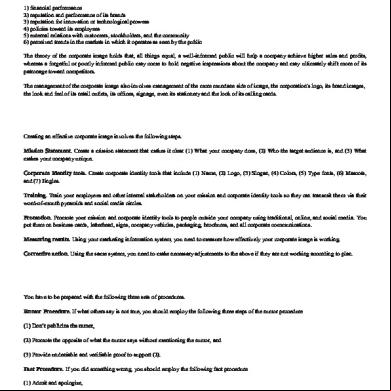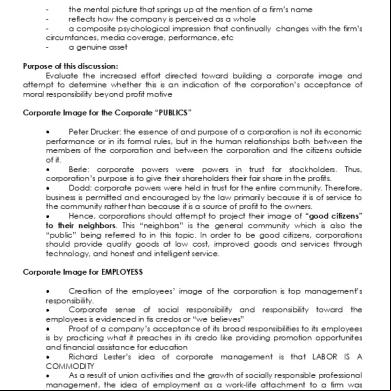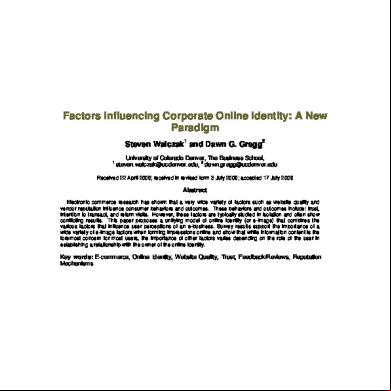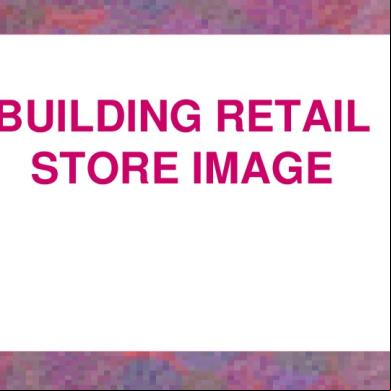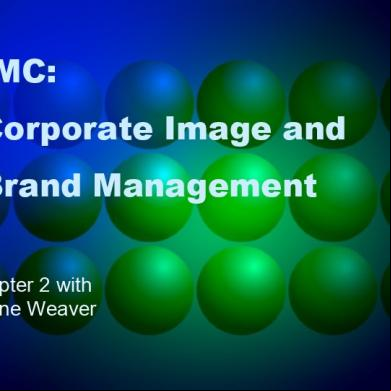Corporate Image Building 2p185t
This document was ed by and they confirmed that they have the permission to share it. If you are author or own the copyright of this book, please report to us by using this report form. Report 3b7i
Overview 3e4r5l
& View Corporate Image Building as PDF for free.
More details w3441
- Words: 1,880
- Pages: 8
CORPORATE IMAGE BUILDING Module 1 - Introduction
Elements of corporate image are 1) financial performance 2) reputation and performance of its brands 3) reputation for innovation or technological prowess 4) policies toward its employees 5) external relations with customers, stockholders, and the community 6) perceived trends in the markets in which it operates as seen by the public The theory of the corporate image holds that, all things equal, a well-informed public will help a company achieve higher sales and profits, whereas a forgetful or poorly informed public may come to hold negative impressions about the company and may ultimately shift more of its patronage toward competitors. The management of the corporate image also involves management of the more mundane side of image, the corporation's logo, its brand images, the look and feel of its retail outlets, its offices, signage, even its stationery and the look of its calling cards.
Creating an effective corporate image involves the following steps. Mission Statement. Create a mission statement that makes it clear (1) What your company does, (2) Who the target audience is, and (3) What makes your company unique. Corporate Identity tools. Create corporate identity tools that include (1) Name, (2) Logo, (3) Slogan, (4) Colors, (5) Type fonts, (6) Mascots, and (7) Jingles. Training. Train your employees and other internal stakeholders on your mission and corporate identity tools so they can transmit them via their word-of-mouth pyramids and social media circles. Promotion. Promote your mission and corporate identity tools to people outside your company using traditional, online, and social media. You put them on business cards, letterhead, signs, company vehicles, packaging, brochures, and all corporate communications. Measuring results. Using your marketing information system, you need to measure how effectively your corporate image is working. Corrective action. Using the same system, you need to make necessary adjustments to the above if they are not working according to plan.
You have to be prepared with the following three sets of procedures. Rumor Procedure. If what others say is not true, you should employ the following three steps of the rumor procedure (1) Don’t publicize the rumor, (2) Promote the opposite of what the rumor says without mentioning the rumor, and (3) Provide undeniable and verifiable proof to (2). Fact Procedure. If you did something wrong, you should employ the following fact procedure (1) it and apologize, (2) Limit the scope (or put the mistake in perspective), and (3) Propose a solution so the mistake is unlikely to reoccur. Turn negatives into positives. On a transactional basis, misunderstandings and other negative situations will occur between you, your company, and your target audience. You need to do what you can to turn these into positives to
(1) neutralize the negative before it turns into a conflagration that does serious damage to your image and (2) develop a closer relationship with the person (or people) that feel “wronged” by your company.
The most important groups are the stakeholders: - Stockholders: who have invested in the company - Board of Directors: who manage the company - Employees: who is in middle management and below - Suppliers: who supplies any kinds of materials and services (banks) - Channel : who are involved in the distribution network - Customers: who purchase the company’s products and/or services - Community: who asses the company’s role as corporate citizen
Since a corporation’s image affects stakeholders’ behaviour, companies strive to develop and manage it for the various reasons: - stimulating sales - establishing company goodwill - creating an identity for employees - influencing investors and financial institutions - promoting favourable relations with the community, government and opinion leaders - achieving a competitive position
Forming corporate image . . . . Step 1: Influence and manage corporate image
- internal controllable sphere Through 6 major sources -
Corporate Identity - this is the so-called “ideal” self-image. It is how a company chooses to identify itself to the public, how it projects itself to the public
-
Corporate Advertising - Communicating the organization’s identity in the way that the achievement of company’s goals is facilitated. This is a management responsibility. Institutional advertising generates awareness and goodwill of a company behind a product or service.
-
Brand Image - Why is Brand A more successful than Brand B? Brand image plays an important role to the success of a product. It consists of functional, symbolic and experiential aspects. This is when there is a significant interaction between brand and corporate image.
-
Public Relations - A means to build up a general reservoir of goodwill. These can be for example sponsoring local events and contributing to charities, which can project an image of “good corporate citizenship”.
-
Frontline Employees Behaviour - with frontline employees of a company serves to form an impression about that company, e.g. the courtesy and knowledge of the telephone receptionist. Vice versa the behaviour of these employees is influenced by the corporate culture (“the pattern of shared values and beliefs…”) and climate within the organization.
-
Websites - Internet is a potential means of communication to all their stakeholders. It is a part of an integrated marketing communications concept. The help stakeholders gather information, form perceptions, and more than that gives them the possibility to directly respond back. Further websites enable organizations to recreate and reposition themselves to meet the demands of the market place.
- external controllable sphere Information received second-hand through personal experience of friends and colleagues can influence a stakeholders’ image of a corporation. For forming a corporate image on the external sphere there are four major sources: 1.
Industry image - The general image of an industry can have an impact on the one of a company. Think of the insurance industry versus the real estate industry, for example. Thus, it is always a managerial issue whether the image of the industry is positive or negative.
2.
Country-of-Origin Image
3.
Press Reports - Press releases are controlled by a company. Press reports are done by many and all others. People tend to sharpen their idea about a company through the broad variety of news items.
4.
Word-of-mouth - Tends to be highly persuasive and credible and can significantly influence the image a stakeholder forms towards a given company.
Approaches to image management 1. Single image focusing on one attribute important to all stakeholders 2. Single image focusing on most important stakeholders 3. Single image that combines two or more attributes 4. Multiple images directed at different stakeholder groups
Corporate Communication Challenges Naked company syndrome Find the right communities Knowing how to measure its impact Instant communication made possible by smartphones and constant connectivity. Everyone today is an author. Data collection Flexibility Engagement The corporate image can generally be described as what comes to the public’s mind when hearing a company’s name or seeing its logo. This corporate image is built by companies through well-conceived communication programs. Thus, whether a company has a favourable or unfavourable image depends on what the company communicates to the outside world, and how effectively it does that.
The corporate reputation refers to the public’s overall estimation of a company’s performance and attributes over time. Unlike the corporate image, a corporate reputation is earned through (long-term) consistent performance, reinforced by effective communication. Since corporate reputation is built over time, it has a relatively more stable and enduring nature than the corporate image.
The Organisational Identity Dynamics Model
SERVQUAL
MODEL
SERVQUAL is built on the expectancy-disconfirmation paradigm, which in simple means that service quality is understood as the extent to which consumers' preconsumption expectations of quality are confirmed or disconfirmed by their actual perceptions of the service experience. It represented a breakthrough in the measurement methods used for service quality research.
The 5 dimensions that the Servqual questionnaire covered are Reliability
Assurance Tangibles Empathy Responsiveness It also identifies 5 gap areas in the model Gap 1 – The Knowledge Gap Gap 2 – The Standards Gap Gap 3 – The Delivery Gap Gap 4 – The Communications Gap Gap 5 – The Perception Gap
VISION CULTURE IMAGE MODEL
REPUTATION TRACK MODEL Performance Products / Services Innovation Workplace Governance Citizenship Leadershp
Griener’s Growth Stages Model
Stage 1 – Growth through Creativity Stage 2 – Growth through Direction Stage 3 – Growth through Delegation Stage 4 – Growth through Co-ordination Stage 5 – Growth through Collaboration
EMPLOYER BRANDING BEST PRACTICES Clarity about what to stand for: An organization’s mission, vision, and values should be clearly defined and this should flow through to your employer branding communications. Two of the standout companies in this area are Apple and Starbucks. Awareness of political risks: The risks of shifting manufacturing and/or production offshore and/or recruiting talent from outside local borders has to be weighed up against the risks of not doing so. Increasingly due to the threat of terrorism, quality concerns, and corporate agility, companies are reconsidering their appetite for political risks. Digitalising employer brand strategy: The digital technologies underlying talent attraction, engagement and retention may not be new, but they are being used to new effect. Enormous amounts of information are accessible as never before, from what’s being said about your company online to internal forums focused on improving business processes. Network is the net worth: The key is to continuously organically grow the network. Ensure to have global reach on the network and it is diverse enough to ensure we are learning and connecting with people from a range of talent from different backgrounds. Foster relevant lifelong learning: For the cost of under $500 for a tablet or smartphone companies can put self-learning at the fingertips of employees and train them on how to get the information to come to them. There are an increasing number of open-source free education websites available to anyone with an Internet connection. Role of CSR: Corporate Social Responsibility is a good employer branding tactic that influences how people perceive a brand positioning in the market, in comparison to the competition. Optimising communication flow: There are a range of tools such as IBM’s social software solutions to the communication flow inside and outside an organisation. These tools assist organisations of all sizes to work smarter, become more agile, and foster innovation. On-boarding as an equally important experience: When people any company, they are either too excited or too nervous - the team at Management Study Guide writes. Both are extreme conditions, which needs to be handle well. Adopt a Community Concept to Your Employer Brand Strategy: Make Sense of Big Data at Your Disposal Look Outside Your Own Borders
The components of CI strategy • • •
Corporate behavior Visual identity Corporate communications
Corporate Image School of Thoughts -
Transmitter of Images a. Projected Image b. Visual Image c. Desired future image
-
Received End Images a. Transient Image b. Corporate Reputation c. Brand Image d. Stereotype Image
-
Focus of image a. Brand Image b. Industry image
-
Construed Images DEAR – Decisions Evaluated Against Reputation
• •
Corporate Identity Organizational identity
• • • •
Corporate Communications Corporate Branding Corporate Reputation Corporate Image
MEASURING BRAND EQUITY Qualitative Free Associations Projective Techniques Experimental / New Age
Quantitative Brand awareness - recognition and recall Brand Image Multidimensional Scaling Brand Response Brand Relationships Comparative Cot Analysis Holistic Analysis
Elements of corporate image are 1) financial performance 2) reputation and performance of its brands 3) reputation for innovation or technological prowess 4) policies toward its employees 5) external relations with customers, stockholders, and the community 6) perceived trends in the markets in which it operates as seen by the public The theory of the corporate image holds that, all things equal, a well-informed public will help a company achieve higher sales and profits, whereas a forgetful or poorly informed public may come to hold negative impressions about the company and may ultimately shift more of its patronage toward competitors. The management of the corporate image also involves management of the more mundane side of image, the corporation's logo, its brand images, the look and feel of its retail outlets, its offices, signage, even its stationery and the look of its calling cards.
Creating an effective corporate image involves the following steps. Mission Statement. Create a mission statement that makes it clear (1) What your company does, (2) Who the target audience is, and (3) What makes your company unique. Corporate Identity tools. Create corporate identity tools that include (1) Name, (2) Logo, (3) Slogan, (4) Colors, (5) Type fonts, (6) Mascots, and (7) Jingles. Training. Train your employees and other internal stakeholders on your mission and corporate identity tools so they can transmit them via their word-of-mouth pyramids and social media circles. Promotion. Promote your mission and corporate identity tools to people outside your company using traditional, online, and social media. You put them on business cards, letterhead, signs, company vehicles, packaging, brochures, and all corporate communications. Measuring results. Using your marketing information system, you need to measure how effectively your corporate image is working. Corrective action. Using the same system, you need to make necessary adjustments to the above if they are not working according to plan.
You have to be prepared with the following three sets of procedures. Rumor Procedure. If what others say is not true, you should employ the following three steps of the rumor procedure (1) Don’t publicize the rumor, (2) Promote the opposite of what the rumor says without mentioning the rumor, and (3) Provide undeniable and verifiable proof to (2). Fact Procedure. If you did something wrong, you should employ the following fact procedure (1) it and apologize, (2) Limit the scope (or put the mistake in perspective), and (3) Propose a solution so the mistake is unlikely to reoccur. Turn negatives into positives. On a transactional basis, misunderstandings and other negative situations will occur between you, your company, and your target audience. You need to do what you can to turn these into positives to
(1) neutralize the negative before it turns into a conflagration that does serious damage to your image and (2) develop a closer relationship with the person (or people) that feel “wronged” by your company.
The most important groups are the stakeholders: - Stockholders: who have invested in the company - Board of Directors: who manage the company - Employees: who is in middle management and below - Suppliers: who supplies any kinds of materials and services (banks) - Channel : who are involved in the distribution network - Customers: who purchase the company’s products and/or services - Community: who asses the company’s role as corporate citizen
Since a corporation’s image affects stakeholders’ behaviour, companies strive to develop and manage it for the various reasons: - stimulating sales - establishing company goodwill - creating an identity for employees - influencing investors and financial institutions - promoting favourable relations with the community, government and opinion leaders - achieving a competitive position
Forming corporate image . . . . Step 1: Influence and manage corporate image
- internal controllable sphere Through 6 major sources -
Corporate Identity - this is the so-called “ideal” self-image. It is how a company chooses to identify itself to the public, how it projects itself to the public
-
Corporate Advertising - Communicating the organization’s identity in the way that the achievement of company’s goals is facilitated. This is a management responsibility. Institutional advertising generates awareness and goodwill of a company behind a product or service.
-
Brand Image - Why is Brand A more successful than Brand B? Brand image plays an important role to the success of a product. It consists of functional, symbolic and experiential aspects. This is when there is a significant interaction between brand and corporate image.
-
Public Relations - A means to build up a general reservoir of goodwill. These can be for example sponsoring local events and contributing to charities, which can project an image of “good corporate citizenship”.
-
Frontline Employees Behaviour - with frontline employees of a company serves to form an impression about that company, e.g. the courtesy and knowledge of the telephone receptionist. Vice versa the behaviour of these employees is influenced by the corporate culture (“the pattern of shared values and beliefs…”) and climate within the organization.
-
Websites - Internet is a potential means of communication to all their stakeholders. It is a part of an integrated marketing communications concept. The help stakeholders gather information, form perceptions, and more than that gives them the possibility to directly respond back. Further websites enable organizations to recreate and reposition themselves to meet the demands of the market place.
- external controllable sphere Information received second-hand through personal experience of friends and colleagues can influence a stakeholders’ image of a corporation. For forming a corporate image on the external sphere there are four major sources: 1.
Industry image - The general image of an industry can have an impact on the one of a company. Think of the insurance industry versus the real estate industry, for example. Thus, it is always a managerial issue whether the image of the industry is positive or negative.
2.
Country-of-Origin Image
3.
Press Reports - Press releases are controlled by a company. Press reports are done by many and all others. People tend to sharpen their idea about a company through the broad variety of news items.
4.
Word-of-mouth - Tends to be highly persuasive and credible and can significantly influence the image a stakeholder forms towards a given company.
Approaches to image management 1. Single image focusing on one attribute important to all stakeholders 2. Single image focusing on most important stakeholders 3. Single image that combines two or more attributes 4. Multiple images directed at different stakeholder groups
Corporate Communication Challenges Naked company syndrome Find the right communities Knowing how to measure its impact Instant communication made possible by smartphones and constant connectivity. Everyone today is an author. Data collection Flexibility Engagement The corporate image can generally be described as what comes to the public’s mind when hearing a company’s name or seeing its logo. This corporate image is built by companies through well-conceived communication programs. Thus, whether a company has a favourable or unfavourable image depends on what the company communicates to the outside world, and how effectively it does that.
The corporate reputation refers to the public’s overall estimation of a company’s performance and attributes over time. Unlike the corporate image, a corporate reputation is earned through (long-term) consistent performance, reinforced by effective communication. Since corporate reputation is built over time, it has a relatively more stable and enduring nature than the corporate image.
The Organisational Identity Dynamics Model
SERVQUAL
MODEL
SERVQUAL is built on the expectancy-disconfirmation paradigm, which in simple means that service quality is understood as the extent to which consumers' preconsumption expectations of quality are confirmed or disconfirmed by their actual perceptions of the service experience. It represented a breakthrough in the measurement methods used for service quality research.
The 5 dimensions that the Servqual questionnaire covered are Reliability
Assurance Tangibles Empathy Responsiveness It also identifies 5 gap areas in the model Gap 1 – The Knowledge Gap Gap 2 – The Standards Gap Gap 3 – The Delivery Gap Gap 4 – The Communications Gap Gap 5 – The Perception Gap
VISION CULTURE IMAGE MODEL
REPUTATION TRACK MODEL Performance Products / Services Innovation Workplace Governance Citizenship Leadershp
Griener’s Growth Stages Model
Stage 1 – Growth through Creativity Stage 2 – Growth through Direction Stage 3 – Growth through Delegation Stage 4 – Growth through Co-ordination Stage 5 – Growth through Collaboration
EMPLOYER BRANDING BEST PRACTICES Clarity about what to stand for: An organization’s mission, vision, and values should be clearly defined and this should flow through to your employer branding communications. Two of the standout companies in this area are Apple and Starbucks. Awareness of political risks: The risks of shifting manufacturing and/or production offshore and/or recruiting talent from outside local borders has to be weighed up against the risks of not doing so. Increasingly due to the threat of terrorism, quality concerns, and corporate agility, companies are reconsidering their appetite for political risks. Digitalising employer brand strategy: The digital technologies underlying talent attraction, engagement and retention may not be new, but they are being used to new effect. Enormous amounts of information are accessible as never before, from what’s being said about your company online to internal forums focused on improving business processes. Network is the net worth: The key is to continuously organically grow the network. Ensure to have global reach on the network and it is diverse enough to ensure we are learning and connecting with people from a range of talent from different backgrounds. Foster relevant lifelong learning: For the cost of under $500 for a tablet or smartphone companies can put self-learning at the fingertips of employees and train them on how to get the information to come to them. There are an increasing number of open-source free education websites available to anyone with an Internet connection. Role of CSR: Corporate Social Responsibility is a good employer branding tactic that influences how people perceive a brand positioning in the market, in comparison to the competition. Optimising communication flow: There are a range of tools such as IBM’s social software solutions to the communication flow inside and outside an organisation. These tools assist organisations of all sizes to work smarter, become more agile, and foster innovation. On-boarding as an equally important experience: When people any company, they are either too excited or too nervous - the team at Management Study Guide writes. Both are extreme conditions, which needs to be handle well. Adopt a Community Concept to Your Employer Brand Strategy: Make Sense of Big Data at Your Disposal Look Outside Your Own Borders
The components of CI strategy • • •
Corporate behavior Visual identity Corporate communications
Corporate Image School of Thoughts -
Transmitter of Images a. Projected Image b. Visual Image c. Desired future image
-
Received End Images a. Transient Image b. Corporate Reputation c. Brand Image d. Stereotype Image
-
Focus of image a. Brand Image b. Industry image
-
Construed Images DEAR – Decisions Evaluated Against Reputation
• •
Corporate Identity Organizational identity
• • • •
Corporate Communications Corporate Branding Corporate Reputation Corporate Image
MEASURING BRAND EQUITY Qualitative Free Associations Projective Techniques Experimental / New Age
Quantitative Brand awareness - recognition and recall Brand Image Multidimensional Scaling Brand Response Brand Relationships Comparative Cot Analysis Holistic Analysis
